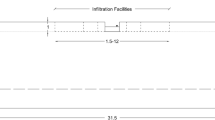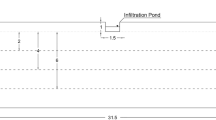Abstract
Infiltration trenches in urban areas are mainly used for the purposes of water balance maintenance and water quality improvement. To ensure that a high enough fraction of runoff from a contributing catchment is infiltrated, trenches are usually sized to provide enough storage capacity so that runoff from a design storm of certain depth can be temporarily stored and infiltrated. Since it is difficult to quantify the actual long-term average runoff reduction ratio provided by individual trenches, their exact long-term average performances are often unknown. In this study, the closed-form analytical equations derived and verified previously for the estimation of the long-term average trench performance are applied in the practical design analysis of infiltration trenches following the detailed design guidelines of Atlanta, Georgia and New Durham, New Hampshire, U.S.. The results demonstrate that the conventional design storm-based design procedure cannot always ensure uniform trench performances because of different site soil and infiltration conditions. Use of the analytical equations (also known as the analytical stormwater models) can facilitate more accurate and consistent design of infiltration trenches because the effects of soil type, trench footprint dimensions, drain time and infiltration conditions on trench performance are all taken into consideration. The analytical equations are recommended as a convenient tool for the proper sizing of infiltration trenches so that a uniform long-term average performance can be achieved for all individual cases.

Similar content being viewed by others
References
Adams BJ, Papa F (2000) Urban stormwater management planning with analytical probabilistic models. Wiley, New York
AMEC Environment and Infrastructure (AMEC) (2014) Green infrastructure stormwater management practices for small commercial development, City of Atlanta Stormwater Guidelines. https://mariettaga.gov/DocumentCenter/View/227/Small-Commercial-Green-Infrastructure-Guidance-PDF?bidId=.pdf
Aquafor Beech Ltd (ABL) (2016) Jurisdictional scan of Canadian, US and international Stormwater management volume Control criteria. Prepared for Ministry of the Environment and Climate Change. Guelph, Ontario, Canada. http://www.downloads.ene.gov.on.ca/envision/env_reg/er/documents/2017/012-9080_Scan.pdf
Aquafor Beech Ltd. and Earthfx Inc. (ABL and EI) (2016) Runoff volume control targets for Ontario final report, prepared for Ministry of the Environment and climate change. Guelph, Ontario http://www.downloads.ene.gov.on.ca/envision/env_reg/er/documents/2017/012-9080_Runoff.pdf
Bach PM, McCarthy DT, Deletic A (2010) Redefining the stormwater first flush phenomenon. Water Res 44(8):2487–2498
Blick SA, Kelly F, Skupien JJ (2004) New Jersey stormwater best management practices manual. https://doi.org/10.7282/T3K64GFK
Burack TS, Walls MJ, Stewart H (2008) New Hampshire Stormwater manual, Volume 2 Post-Construction Best Management Practices: Selection and Design. Comprehensive Environmental Inc.& New Hampshire Department of Environmental Services. https://www.des.nh.gov/organization/commissioner/pip/publications/wd/documents/wd-08-20b.pdf
Chang G, Parrish J, Souer C (1990) The first flush of runoff and its effects on control structure design. Environmental and conservation service department, Environmental Resources Management Division, Austin
Chahar BR, Graillot D, Gaur S (2011) Storm-water management through infiltration trenches. J Irrig Drain Eng 138(3):274–281
Daly E, Bach PM, Deletic A (2014) Stormwater pollutant runoff: a stochastic approach. Adv Water Resour 74:148–155
Eagleson PS (1978) Climate, soil, and vegetation: 2. The distribution of annual precipitation derived from observed storm sequences. Water Resour Res 14(5):713–721
Froehlich DC (2009) Graphical calculation of first-flush flow rates for storm-water quality control. J Irrig Drain Eng 135(1):68–75
Greater Vancouver Sewerage and Drainage District (GVSDD) (2012) Stormwater source Control design guidelines, Vancouver, Canada. http://citeseerx.ist.psu.edu/viewdoc/download?doi=10.1.1.730.8610&rep=rep1&type=pdf
Gregory, M (2015) Flow duration hydrograph analyses for assessing LID performance. J Water Manag Modeling. https://doi.org/10.14796/JWMM.C382
Guo JCY, Urbonas B (2002) Runoff capture and delivery curves for storm-water quality control designs. J Water Resour Plan Manag 128(3):208–215
Guo JC, Urbonas B, MacKenzie K (2014) Water quality capture volume for storm water BMP and LID designs. J Hydrol Eng 19(4):682–686
Guo R, Guo Y, Wang J (2018) Stormwater capture and antecedent moisture characteristics of permeable pavements. Hydrol Process 32(17):2708–2720
Guo Y, Baetz BW (2007) Sizing of rainwater storage units for green building applications. J Hydrol Eng 12(2):197–205
Guo Y (2016) Stochastic analysis of hydrologic operation of green roofs. J Hydrol Eng 21(7):04016016
Guo Y, Gao T (2016) Analytical equations for estimating the total runoff reduction efficiency of infiltration trenches. J Sustainable Water Built Environ 2(3):06016001
Hassini S, Guo Y (2016) Exponentiality test procedures for large samples of rainfall event characteristics. J Hydrol Eng 21(4):04016003
Haubner, SM (2001) Georgia stormwater management manual. Georgia Institute of Technology, Atlanta
Ministry of the Environment and Climate Change (MOECC) (2017) Low impact development (LID) stormwater management guidance manual, Draft version, Toronto, Canada. https://www.municipalclassea.ca/files/7_DRAFT_MOECC_LID%20SWM%20Manual.pdf
Minnesota Pollution Control Agency (MPCA) (2005) The Minnesota stormwater manual, version 1, St. Paul, Minnesota
Ontario Ministry of the Environment (OMOE) (2003) Stormwater management planning and design manual. Ontario, Canada, Toronto
Parolari AJ, Pelrine S, Bartlett MS (2018) Stochastic water balance dynamics of passive and controlled stormwater basins. Adv Water Resour 122:328–339
Pelak N, Porporato A (2016) Sizing a rainwater harvesting cistern by minimizing costs. J Hydrol 541:1340–1347
Park D, Song YI, Roesner LA (2013) Effect of the seasonal rainfall distribution on storm-water quality capture volume estimation. J Water Resour Plan Manag 139(1):45–52
Rodriguez-Iturbe I, Proporato A (2004) Ecohydrology of water-controlled ecosystems. Cambridge University Press, UK
Sartor JD, Boyd GB (1972) Water pollution aspects of street surface contaminant, EPA-R2/72–081. U.S. Environmental Protection Agency, Washington, D.C
Sharifi S, Massoudieh A, Kayhanian M (2011) A stochastic stormwater quality volume-sizing method with first flush emphasis. Water Environ Res 83(11):2025–2035
Tsihrintzis VA, Hamid R (1997) Modeling and management of urban stormwater runoff quality: a review. Water Resour Manag 11(2):136–164
U.S. Environmental Protection Agency (USEPA) (2011) EPA national menu of stormwater best management practices, Washington, DC
Wang J, Guo Y (2018) An analytical stochastic approach for evaluating the performance of combined sewer overflow tanks. Water Resour Res 54(5):3357–3375
Wang J, Guo Y (2019) Stochastic analysis of storm water quality control detention ponds. J Hydrol 571:573–584
Wang, J, Guo, Y (2020) Dynamic water balance of infiltration-based stormwater best management practices. J Hydrol 125174
Water Environment Federation (WEF), ASCE (1998) Urban runoff quality management. WEF Manual of Practice No. 23 and ASCE Manual and Rep on engineering practice no. 87, Alexandria
Zhang K, Che W, Zhang W, Zhao Y (2016) Discussion about initial runoff and volume capture ratio of annual rainfall. Water Sci Technol 74(8):1764–1772
Zhang S, Guo Y (2014) Stormwater capture efficiency of bioretention systems. Water Resour Manag 28(1):149–168
Acknowledgements
This work was supported mainly by the Natural Sciences and Engineering Research Council of Canada (NSERC RGPIN-5112-2016) and the Canadian Mitacs Accelerate Program. Ningbo University in Ningbo, Zhejiang, China provided funding support for the second author’s sabbatical leave from September to December 2018 which contributed to the formation of some of the ideas presented in this paper. The data used in this study are listed in the tables or obtained from the citied references.
Author information
Authors and Affiliations
Corresponding author
Ethics declarations
Conflict of Interest
None.
Additional information
Publisher’s Note
Springer Nature remains neutral with regard to jurisdictional claims in published maps and institutional affiliations.
Rights and permissions
About this article
Cite this article
Wang, J., Guo, Y. Proper Sizing of Infiltration Trenches Using Closed-Form Analytical Equations. Water Resour Manage 34, 3809–3821 (2020). https://doi.org/10.1007/s11269-020-02645-x
Received:
Accepted:
Published:
Issue Date:
DOI: https://doi.org/10.1007/s11269-020-02645-x




